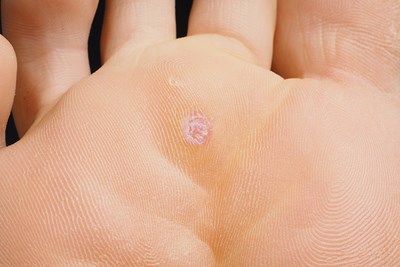All warts generally have one thing in common—they’re caused by the human papillomavirus (HPV). HPV is responsible for over 100 strains of very contagious warts, ranging in severity. Fortunately less serious growths, like plantar warts, are relatively easy to treat. A variety of self-care treatments and surgical procedures are available to relieve discomfort and ultimately remove the wart.
Home Remedies
Home remedies are typically the first attempt when it comes to curing a plantar wart. Treating a wart at home is a relatively inexpensive option and can be just as effective as other treatments.
There are numerous remedies you can try at home. Duct tape, apple cider vinegar, baking soda, and garlic are commonly used. With many of these methods, it usually takes two weeks to a few months to get rid of the wart. However, if you’re not persistent with home treatments, they just won’t work. If you stick to it, your wart should be gone in no time.
Medication
Plantar warts are stubborn and rarely go away after one treatment. Some people find that home remedies just don’t work for them, so the next step involves over-the-counter medications or prescription drugs.
Over-the-counter medications are frequently used to treat plantar warts. Salicylic acid is a core ingredient to many medications. It is applied topically or directly to the wart in the form of a liquid or a patch. The acid eventually eats away at the skin infection and softens the layers around the wart. There are also medications that are continuously used to freeze the wart until it falls off.
Prescription medications are used for more serious infections. Your doctor may recommend a retinoid cream, cantharidin medication, or bleomycin injection. Retinoids are often used to treat acne, wrinkles, and psoriasis but can be used on warts, too. Cantharidin is applied by a doctor and causes the core of the wart to blister and fall off. A bleomycin injection prevents the wart from producing more cells and is injected by a doctor.
Surgery
Surgery is often the last resort for wart removal. It’s usually successful in targeting persistent or recurrent warts, but it is the most invasive of the treatments and requires the most recovery time. Based on the type of wart, a doctor will choose between two options: electrosurgery and curettage, or laser surgery.
Electrosurgery and curettage are two procedures a doctor will combine to remove the wart. For the first part of surgery, an electrically charged needle is used to burn skin off the wart. Next, the doctor scrapes the remainder of the wart out, until the infection is completely gone.
Laser surgery sends a series of pulses to the wart to cut off its blood supply. After a four to five weeks the wart falls off.



